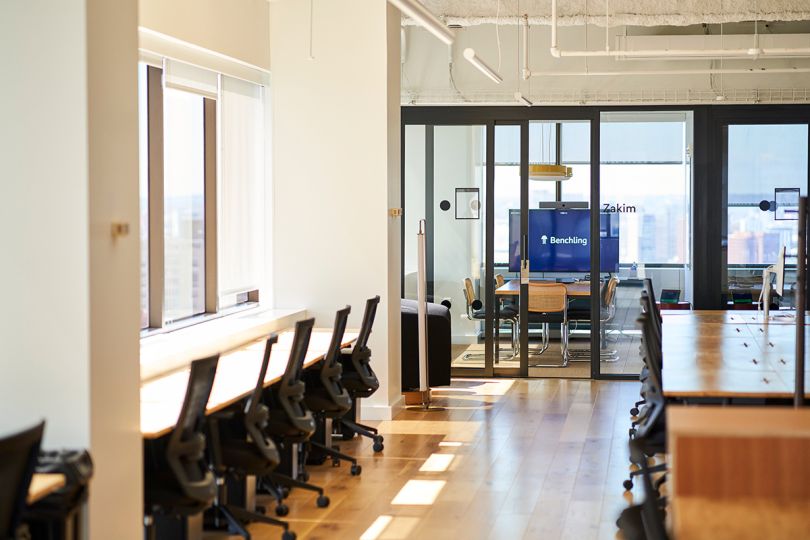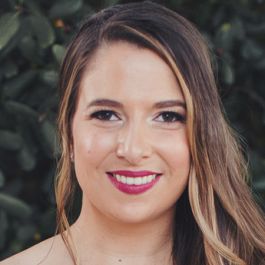It’s July 2021, and a Benchling virtual meeting is in progress. On screen, software engineer Saif Hakim’s Zoom video begins to glitch. A dark synth backing track drops. It’s a simple, stomping rhythm, with a strong emphasis on the downbeat. The instrumental is heavy on the low end, while Hakim unleashes a flow over the top.
Hakim is performing his original track, “Ship It.” It’s a distant cousin of Ice Cube’s “Check Yo Self,” but written for software engineers.
Strategic decisions to take on product debt.
Mostly-finished features are often what you’d get.
But we always remember to pull from our backlogs.
Best-in-class team, here. Yeah, we got stacked odds.
Hakim ends with a mic drop to kick off the Benchling Polish Bash. The bash is an annual event where the engineering team sprints to produce hundreds of product refinements to improve the user experience.
These musical preludes started years ago when Hakim was asked to kick off a hackathon by singing the “Star-Spangled Banner.” It snowballed into an annual tradition from there, morphing from loyal song renditions into lighthearted original compositions like “Ship It.”
About Benchling
Benchling has always been a musical safe haven for Hakim. A few years ago, he bought a digital piano to help curb his workaholic tendencies. But playing and singing at home is challenging in San Francisco, where neighbors and roommates lurk everywhere.
“I wanted to find a quiet space where I could play out loud and realized our office space would work. I asked if I could keep my piano there. At the end of the day or during happy hours, I ask the people who are around if it’s okay for me to play,” said Saif. “Benchling has always been very accommodating in letting the employees help define the office experience.”
Benchling is a place where people can bring themselves to work. But during the pandemic, that physical space went on hiatus. Now in post-vaccination America, the company recently reopened new offices in San Francisco, Boston and Zurich.
The company tapped its return-to-office committee, including Head of IT and Workplace Dana Chamorro and Vice President of People Meg Makalou, to lead the way. The team worked hard to create a hybrid environment that is truly equitable between its remote and flexible in-office workforce. They used the soft opening in San Francisco as a template for the Boston office, using regular employee feedback to guide the way.
Navigating the Return
Built In spoke with Saif, Chamorro and Makalou about the reopenings and the ways Benchling employees are defining the workplace.

How has Benchling supported employees as the nature of the workplace has changed over the past few years?
Dana Chamorro: The pandemic was my first big workplace project. There was an important decision to make without a ton of information. When we eventually concluded it would be indefinite work from home, we packed everything up and closed our offices, knowing we’d start fresh when it was safe to return. Right away we offered a home office stipend, which evolved over time. Now if you’re an in-office employee you get one amount, if you are remote you get a higher amount.
Meg Makalou: In-office people get a stipend because we have a flexible in-office policy. Coming out of the pandemic, we’ve tried to focus on a few different work modes. We have field-facing, fully remote, and in-office employees. In-office employees are in the office three or more days a week — it’s a new level of flexibility. We built out those three modes so we could optimize for each. It’s fine if people want to change over time, but we’ve asked them to opt into one so we can curate the experience to create benefits and support for them.
Saif Hakim: I’m planning on being a hybrid, in-office worker. Some days I need to focus without interruptions. I like to think of the workplace as being slightly less focused by design because it allows for spontaneous interactions with coworkers.
I look at the workplace through the lens of how it fosters collaboration. A big part of the culture is how it enables folks from different parts of the organization to interact. The office space itself is a pretty important conduit for that. Physically having a space to move around and talk to each other is so valuable — so many of my best conversations have been in the kitchen.
What was the office opening process like?
Chamorro: The San Francisco soft opening was months in the making. There was a lot of intention to create an equitable hybrid environment. We wanted the remote population to feel like they are in the office with us. The feedback was overwhelmingly positive, but we also got some constructive feedback to make tweaks for the opening of the Boston office, such as for the registration process. The SF opening helped create a template, a runbook, for the Boston office to move super quickly.
The soft opening was a controlled environment, we sent out feedback surveys every week. I had the pleasure of attending the San Francisco and Boston openings. There was so much love from everyone, there was a deep level of gratitude after being isolated for so long.
“There was a lot of intention to create an equitable hybrid environment. We wanted the remote population to feel like they are in the office with us.”
Makalou: A lot of people were anxious to get back into the office because we had such a vibrant office culture. There are also people in home scenarios where they live in high-risk households — I’m one of them — who didn’t like working from home but had to be cautious. We had to think through those scenarios and whether we require vaccines, boosters and testing. What the level of safety would be?
We’re a science-based company, so we do require vaccines and boosters. Initially, we had people test every day, and now we test every other day. There was a lot of planning and logistics, but you have to constantly inspect and modify it.
Hakim: It felt so nice to go from Zoom to real life. I enjoyed being able to have candid, casual conversations. Zoom meetings often have some formality to them, you usually need a reason to book someone’s time. Whereas in an office, you can just intentionally hang out in a cafeteria to strike up a conversation.
Employees have always had the opportunity to be involved in our office openings, such as in window shopping for the locations and helping to name the conference rooms. I named three: Vivo, Vitro, and Silico. It’s a biology pun because you can say, “Let’s meet in vitro.”
Describe your company culture. Are there any stories that exemplify what it’s like?
Makalou: This culture is high transparency and high humility. Whatever is safe to share, we share it as soon as possible. When we have board meetings, we share immediately after and discuss at an all-hands with very little redacted. That was important during the pandemic when nothing felt tangible and you were just trusting people in boxes on Zoom. Our employees took leaps of faith with us, so we put a lot of trust back into the system by trusting employees with information.
We spend as much time sharing positive results as we do mining for things that didn’t go as well. You take more away learning from a painful loss, and it’s an important cultural norm to build into the company. We’re not confused about the fact that we’re a bunch of flawed human beings trying to do our best. There will be mistakes and the worst thing we could do is create a narrative that mistakes should be hidden. Those cultural pillars have been important for people to feel like they can be their whole selves at work.
Hakim: We used to have four couches in the corner of the office for naps and had a Slack channel called #Bench-Lying where we shared photos. I was once caught in the corner of a video presentation on one of the couches, napping and snoring lightly in the background. I’d stayed up late working on an issue for a customer the night before. So they understand the importance of being well-rested, and it was nice to have the ability to be that vulnerable with your coworkers. We have too many employees now to have enough couches, but it’s a fond memory.
How is the company building an equitable hybrid experience?
Hakim: Meetings are well-run and equitable for both remote and in-office workers. A big part of that has been finding the right technologies, such as Figma, to enable that collaboration. All of our conference rooms have good Zoom setups with big TVs and mics along the tables. The cameras detect who is in the room and zoom out to ensure everyone is in the frame. It has to be good from a remote-first standpoint.
Beyond meetings, if you are just running into a problem in your independent work, you can just drop a Zoom command into our Slack to start a meeting quickly. It’s a normalized thing to do.
Chamorro: We did a few things different this time than in our past office builds. We increased space per square foot by 25 percent for each employee. That enables us to expand the workstations neighborhoods, collaboration areas and conference rooms. We also looked at alternate ways for people to do heads-down work. We intentionally built flexible spaces, so if the feedback shows we need to make a change, we can. We have portable Zoom whiteboards to bring in remote people without booking a conference room. We have flex conference rooms with Zoom whiteboards and modular furniture.
“We intentionally built flexible spaces, so if the feedback shows we need to make a change, we can.”
Makalou: What helps is that everybody just lived through being remote, so they know what it feels like. There’s that lived empathy so even if you return to the office you deeply understand what it’s like to be remote.

What’s exciting about working at Benchling? What should tech talent know?
Hakim: I joined right after college nine years ago and have no interest in leaving. I wanted to do something humanity-focused. Biotech is doing so many important things. I can build software to level up the tools that scientists are using. It has an impact on people, as Covid-19 demonstrated.
Makalou: There are so many access points to the mission of this company. The software we build is rewriting the way we live, in areas such as healthcare, food production and the environment. It’s important to me to work somewhere that is contributing to something I care about. There are so many traumatic things happening right now, all over the world, and it’s hard to find words that feel helpful. I struggle with that, but it makes me think about how I spend my time. It’s sustaining for me that I spend a lot of my time with a bunch of very purpose-driven, empathetic people who feel optimistic about good change that we can make in the world. It provides an important reservoir of hope for me.
“Employees here have both a high IQ and a high EQ. It’s a rare combination.”
Hakim: I’ve just always been excited about what we are doing. But, right now, the fact that we have a workplace team making the reopening as smooth as possible is great. There are always scaling challenges from both a technical and people standpoint. When your headcount doubles, that has a big impact on how the office works. I’m glad that we have folks who are very thoughtful about that. Employees here have both a high IQ and a high EQ. It’s a rare combination.







